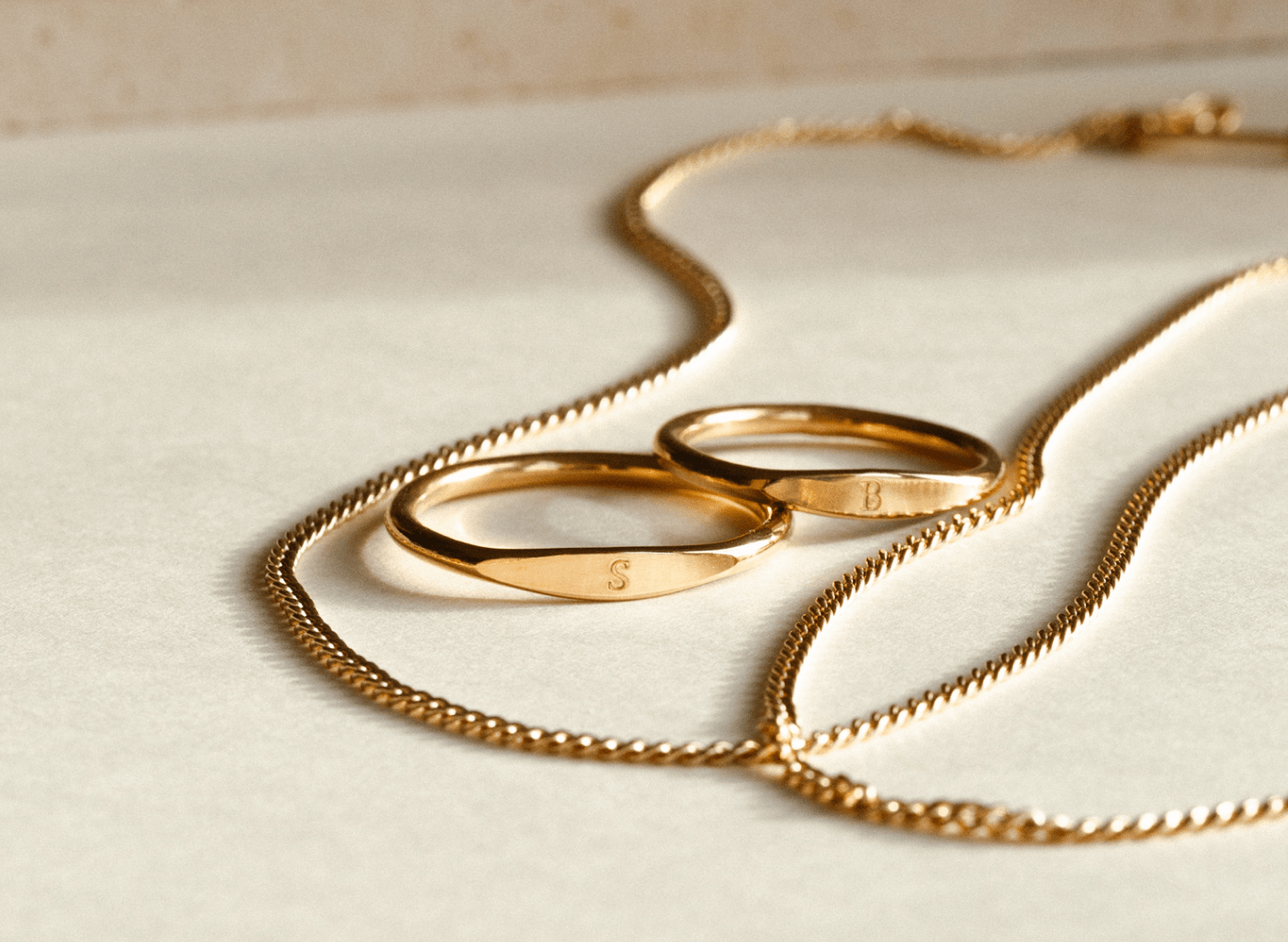What is 14k Gold Fill Jewelry? | GLDN

You see it everywhere: jewelry brands selling 14k gold-filled jewelry left and right. But what is 14k gold-filled? What does 14k gold-filled mean? Is it actually good (or is it just a buzzword)?! We compiled a quick Q&A with all the info you need about 14k gold-filled jewelry—what it is, why we use it, why it’s durable, why it’s great for anyone with skin allergies and why it totally lives up to the hype (even at its affordable price). ✨

What is 14K gold-filled?
Let’s start with the basics: what does 14k gold-filled mean? “Gold-filled” is a USA industry standard that legally requires a jewelry piece to be 1/20th (or 5%) pure gold by weight! To create gold-filled jewelry, you pressure-bond multiple layers of 14k solid gold to a jeweler’s brass core using extreme heat. It’s a strictly regulated process that creates a durable, high-quality piece made with real gold…without the solid gold price tag.
Is "gold-filled" the same as "gold fill"?
You probably see these terms used interchangeably—that’s because “gold fill” and “gold-filled” mean the same thing! If there’s no indication of how many karats the gold is (i.e., 14k gold-filled or 10k gold-filled), you can probably assume "gold-filled" or “gold fill” in the United States refers to 14k gold-filled. It’s the most common karat of gold used in gold-filled pieces—as much as 95% of pieces use 14k gold! You might also see a jewelry piece marked with 14k gf or 14kgf, meaning the piece is gold-filled!
Is gold-fill actually "filled with gold"?
On the contrary: the gold in gold fill jewelry is actually on the outside of the piece. I’m not sure why the industry decided on “gold-filled” to identify this kind of jewelry—it’s confusing, since it really has nothing to do with being filled with gold! The only thing you need to know is that the terms “gold fill” and “gold-filled” refer to a thick outer layer of durable, pressure-bonded solid gold. So, if you’re wondering if gold filled is real gold…it is! Just on the outside of the piece, not the inside.
Is gold-filled jewelry real gold?
And if not, what does gold filled mean? To start, the gold used in 14k gold-filled jewelry is 100% real. There’s a thick layer of real, solid 14k gold on the outside of a brass core, though, instead of the inside, making the term “gold filled” or “gold fill” sound a little misleading. The 14k gold on the outside of gold-filled is the same gold you’d get from a 14k solid gold piece. So, if you’re wondering the difference between gold-filled vs. solid gold jewelry, the main thing to note is this: gold-filled jewelry has a layer of solid gold bonded to a brass core, while solid gold is solid gold all the way through.
How much real gold is in gold fill?
And what does gold-filled mean? By legal definition, gold-filled jewelry is required to include a minimum of 1/20th (5%) solid gold by weight. The 5% gold in gold-filled jewelry may not sound like a lot, but it's plenty to keep your jewelry looking great for many years (and if treated with care, a lifetime!).
What are the advantages of 14K gold-filled jewelry?
Gold filled jewelry offers the advantages of solid gold at a more affordable price. With its thick layer of gold bonded to the base metal core, it is durable, resistant to tarnish, and maintains its shine over time making it a great choice for everyday wear! Here are the pros of gold filled jewelry:
- The gold won't rub off
- It's waterproof and tarnish resistant
- It's safe for sensitive skin
- It's durable
- It's cheaper than solid gold
- It's easy to care for
- It resembles solid gold
Is "rose gold-filled" different?
If you see "rose gold-filled," you can assume we mean "14k rose gold-filled", rather than yellow gold. The piece is still 14k gold filled, meaning it’s made of high-quality solid gold over a brass core! This difference refers to the actual color of the gold, not the quality or durability. Both 14k yellow gold and 14k rose gold alloys contain the same amount of 14-karat solid gold. It’s the combination of metals added to the pure 24k gold that changes the color—the amount of pure gold is constant. Our post here details how gold can be different colors!
How are gold-filled items marked?
Sometimes you’ll find a “14/20 GF” or “14k GF” mark on gold-filled pieces. Often, handmade gold-filled pieces (like ours!) from smaller companies won't be marked, though. For example, we don’t mark our rings and many other pieces, but we do have a mark on our chains (at the clasp). To determine what pieces are gold-filled, look at the item’s description or tag—that’s typically your best bet.
Can you be allergic to gold-filled jewelry?
If you’re allergic to solid gold jewelry, you’d most likely be allergic to gold-filled jewelry too—since it’s covered with a thick layer of solid gold. If you’re not allergic to solid gold, however, wearing gold-filled jewelry is completely safe (since the base metal inside the piece, typically brass, is coated in gold)!
Why do colors vary between gold-filled jewelry pieces?
Gold-filled jewelry has taken off in the past few years—meaning tons of jewelers using tons of different processes are creating gold-filled pieces, and there’s bound to be some subtle variance. Some jewelers will opt for gold-filled jewelry that’s more yellow, brassy, tawny or dark than the industry standard, depending on their customer’s preferences. Many jewelers will add an extra gold plating to their gold-filled pieces for a high-polish finish.

Filled vs. Plated
What's the difference between gold-filled and gold plated?
There’s a lot less gold in gold-plated jewelry compared to gold-filled jewelry, meaning gold-filled jewelry is higher quality. The gold in gold-filled pieces is also pressure-bonded to the brass core to be way more durable! The standards for 14k gold-fill are also strictly regulated, while the standards for "gold plated" encompass a broad range of thicknesses, so you can't be sure how much gold is in the plated layer.
Is gold-filled better than plated?
Yes—and that’s just a fact! We explore both processes in depth in another post here.

Is gold filled and gold vermeil the same?
No, they’re not! Gold vermeil is very similar to gold-plated jewelry, in that it contains much less gold than gold-filled jewelry. Gold vermeil is used to describe a more premium version of gold plating in which more gold is used, but it still isn’t pressure-bonded to the brass core like in gold-filled jewelry. This pressure-bonding makes a huge difference in the jewelry’s ability to resist wear and tear, which is why we’ll always recommend gold-filled jewelry over gold vermeil jewelry for everyday pieces.
Quality of 14k Gold-Fill
Is 14k gold-filled good quality?
14k gold-filled is absolutely your best option after solid gold in terms of quality and durability. 14k gf won’t flake off or turn your skin green, and it’s a great option for people with sensitive skin. We only use the best USA made gold-filled components and stand behind our product’s quality. Gold-filled jewelry can stay beautiful for a lifetime, especially with a little care.
Is gold-filled jewelry durable? How long does it last?
After solid options, gold-filled jewelry is certainly your best quality for gold pieces. In theory, gold fill items can last a lifetime! Get this: some gold-fill jewelry still exists from the Victorian era (over 100 years old!). In practice, actual longevity will depend on how you care for it and a variety of other factors.
Does gold-filled tarnish?
14k gf jewelry should not tarnish for a long time—decades if treated properly. It's possible for gold fill to tarnish under certain conditions or when interacting with certain chemicals (like chlorine, for example), but it should not tarnish easily. To learn how to prevent tarnish, check out this handy post here.
Does it contain nickel?
No, none of our jewelry contains nickel!
Is gold-filled jewelry okay for people with sensitive skin?
Yes! 99.9% of people find they have no sensitivity to gold-filled jewelry. Because the outside of the piece is solid 14k gold, it interacts with your skin in the same way solid 14k gold would. If you don’t have any sensitivities to solid gold, gold-filled jewelry is A-OK.
Will it turn my skin green?
Nope! There have been very rare instances where certain people's body chemistry reacts with 14k gold (and creates a green residue on their skin) but this happens in approximately 0.001% of people—so it shouldn’t be a concern. Body chemistry is a fascinating thing, and it’s often medication to thank for rare instances like this!
Will it flake off?
Again, nope! With gold-filled jewelry, the outer layer of solid gold is mechanically bonded to the brass core through extreme pressure and heat. This creates a resilient exterior that’s not prone to flaking or cracking. Flaking is more common with certain types of gold plating and uncommon with gold filled!Does it Rust?
Nope. Rust isn't possible with the metals present in gold-filled material. Bless. 🙏

Caring for 14K gold-filled jewelry
Do I have to take gold-filled jewelry off to shower?
Not if you use mild soaps—they can actually help passively clean your gold-filled jewelry while you shower. All caps necessary for this one: MAKE SURE your shampoos and soaps are gentle, as certain chemicals can negatively impact the look of the gold. If you're not sure, just be safe and remove your jewelry before showering. I personally shower with my jewelry on all the time, but I use Dove soap and natural shampoo (for a happy ocean and happy jewelry).
Can I sleep in my gold-filled jewelry?
Yes, but it won't last as long. Sleeping in your gold-filled jewelry won’t damage the surfaces of your pieces, but you could easily snag your delicate pieces (like dainty chains or bracelets) on your sheets or PJs. If you can remember to take your pieces off before bed, they'll thank you by staying bright longer! You could even quickly wipe down your jewelry before sleep—add this to your nighttime routine—to remove oils from the surface of the metal.
How do I take care of gold-filled jewelry?
The best care you can give your pieces is this: gently clean with water and mild soap, dry with a soft cloth (eyeglass chamois work great!) and only polish them when they really need it. If your pieces come into contact with lotions, sunscreen or perfumes, rinse off your jewelry immediately—especially important for gold-filled chains with tiny nooks and crannies. The care card we include with each order details all these tips, but you can find even more info in this post.✨

Why aren’t all our items gold-filled?
We offer most of our chains and pieces in 14k gold fill, but some pieces are more difficult to create this way—like shaped charms and hoop earrings, to name a few. Sometimes we opt for gold plated for these “molded” designs that must be cast (a process incompatible with gold-filled material).
Why can’t you cast gold-filled?
In short, the jewelry casting process involves pouring liquid metal into a mold. If you melted down gold-filled material, the gold would no longer be only concentrated on the outside and you’d end up with something more like 2k gold (instead of 14k gold outside of a brass core) The only way to make gold-filled material requires massive amounts of pressure and heat. Like, massive! Not something that you’d be able to do outside a dedicated factory.
What’s the solution?
For the pieces we must make in 14k gold-plated, we make sure we use as much gold plating as we can (and, of course, use 14k gold-filled or solid gold for everything else). We’ll often add an extra layer of protection over any gold-plated components to increase durability!


Very helpful thanks